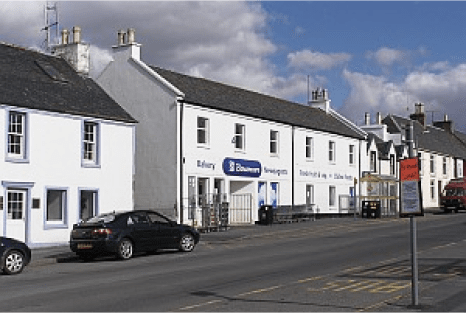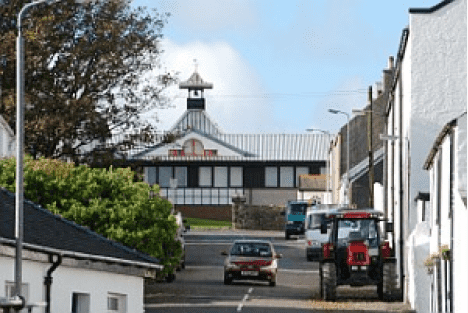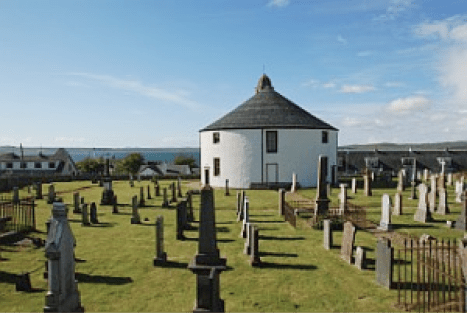Bowmore

Bowmore is Islay’s administrative capital and has lots to offer. You’ll discover plenty of shops in Bowmore’s Main Street which runs from the Round Church down to the picturesque harbour. On Fridays, fish can be bought at the little trailer which parks between the Round Church and the Co-op supermarket in The Square. The Post Office, a bank and restaurants such as the Harbour Inn, near the harbour, and the Cottage Restaurant, halfway up Main Street, can be found in Bowmore’s lovely centre.

Bowmore is also home to the local newspaper called the Ileach, their offices located halfway up Main Street, which is printed fortnightly and is sold in almost every supermarket on the island. In 2006 the Ileach was rewarded with the title community newspaper of the year. Another interesting building to see is the Islay High School. The school is located up the hill on School Street behind the Bowmore distillery and has a pagoda built on the roof which resembles the distillery malt kiln chimney also seen at Bowmore and other distilleries. The village hall in Main Street, where community events such as dances and concerts are held, was built in the late 18th century. The upper rooms were formerly used as the Sherrif Court and library. Other facilities in Bowmore are a hospital, dentist, banks, and the Argyll and Bute Council (local government) offices on Jamieson Street off Main Street, which provides local services and meeting rooms, and also free internet access. The bus station in Main Street connects all the villages on Islay and busses leave frequently on their several routes over the island.
Just outside Bowmore in the direction of Bridgend, the A846 passes the Columba Centre, Ionad Chaluim Chille Ìle, Islay's Gaelic College where Gaelic is taught and art exhibitions can often be visited. Continuing along the beautiful shore of Loch Indaal, there are several laybys where you can leave the road to enjoy the magnificent views over Loch Indaal and/or watch the wildlife on the sandflats at the head of the loch.
Bowmore Distillery
Bowmore is probably most famous for its whisky distillery. The distillery lies on the shore of Loch Indaal and is in the heart of the town. Next to the distillery in a converted warehouse is the MacTaggart Leisure Centre, which opened in 1991. The water from the swimming pool is warmed by Bowmore Distillery's surplus heat.
Bowmore Round Church

The view from the church towards Loch Indaal is magnificent and from there you have an overview of the whole Main Street. The Round Church itself, parish church of Killarrow, was built in 1767 by Daniel Campbell of Shawfield and Islay, then owner of the entire island. The interior of the church is beautiful and should be on everybody's itinerary. The story goes that the church was built in a circular shape to make sure there were no corners for the devil to hide in. The gallery was added in about 1830 and the organ in 1890. There is a sandstone slab containing the following Latin inscription (translated): ‘With pious intent, and to promote truth and honour, Daniel Campbell, lord of this island, built at his own expense in the year 1767, this church dedicated to the supreme God’.
Other important monuments are an obelisk-headed mural monument of white marble commemorating Walter Campbell of Shawfield and Islay who died in 1816, a tomb-chest set within an ogival-moulded canopy commemorating Margaret Susan Campbell, daughter of Walter Frederick Campbell, who died in infancy in 1822 and a large twin-chambered black marble sarcophagus erected to commemorate Lady Ellinor Campbell (d. 1832) and Walter Frederick Campbell, who died in Normandy in 1855.
Bowmore history
The village of Bowmore was founded in 1768, by Daniel Campbell of Shawfield and Islay. Construction of this first planned village in Scotland was part of a resettlement scheme to move people from the old village of Killarrow which was near Islay House. Bowmore’s streets are laid out on a grid pattern, based on the axis of Main Street and ascending over a distance of about 300 m from the pier to the Round Church. Originally, small fields were left between the rows of houses so that the inhabitants could grow their families’ food and keep a milking cow, but these fields now have houses built on them. The first pier was built in 1750 and has been subsequently extended and rebuilt, notably during WWII when it was reinforced and a breakwater was added. A sea plane base existed here during WWII when Sunderland and Catalina flying boats operated from Loch Indaal.